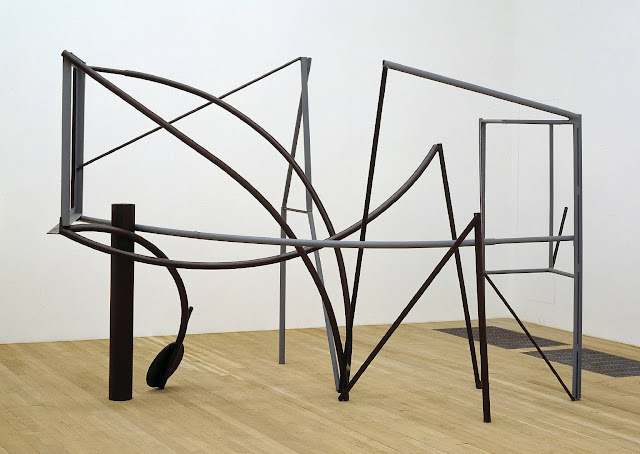Sir Anthony Alfred Caro (8 March 1924 – 23 October 2013) was an English abstract sculptor whose work is characterised by assemblages of metal using 'found' industrial objects. His style was of the modernist school, having worked with Henry Moore early in his career. He was lauded as the greatest British sculptor of his generation
"Anthony Caro (1924 - 2013) has played a pivotal role in the development of twentieth century sculpture. After studying sculpture at the Royal Academy Schools in London, he worked as assistant to Henry Moore. He came to public attention with a show at the Whitechapel Gallery in 1963, where he exhibited large abstract sculptures brightly painted and standing directly on the ground so that they engage the spectator on a one-to-one basis. This was a radical departure from the way sculpture had hitherto been seen and paved the way for future developments in three-dimensional art.Caro’s teaching at St Martin’s School of Art in London (1953 -1981) was very influential. His questioning approach opened up new possibilities, both formally and with regard to subject matter. His innovative work as well as his teaching led to a flowering and a new confidence in sculpture worldwide.
Caro often works in steel, but also in a diverse range of other materials, including bronze, silver, lead, stoneware, wood and paper. Major exhibitions include retrospectives at the Museum of Modern Art, New York (1975), the Trajan Markets, Rome (1992), the Museum of Contemporary Art, Tokyo (1995), Tate Britain, London (2005), and three museums in Pas-de-Calais, France (2008), to accompany the opening of his Chapel of Light at Bourbourg. He has been awarded many prizes, including the Praemium Imperiale for Sculpture in Tokyo in 1992 and the Lifetime Achievement Award for Sculpture in 1997. He holds many honorary degrees from universities in the UK, USA and Europe. He was knighted in 1987 and received the Order of Merit in May 2000."(anthonycaro.org)
"Anthony Caro (1924 - 2013) has played a pivotal role in the development of twentieth century sculpture. After studying sculpture at the Royal Academy Schools in London, he worked as assistant to Henry Moore. He came to public attention with a show at the Whitechapel Gallery in 1963, where he exhibited large abstract sculptures brightly painted and standing directly on the ground so that they engage the spectator on a one-to-one basis. This was a radical departure from the way sculpture had hitherto been seen and paved the way for future developments in three-dimensional art.Caro’s teaching at St Martin’s School of Art in London (1953 -1981) was very influential. His questioning approach opened up new possibilities, both formally and with regard to subject matter. His innovative work as well as his teaching led to a flowering and a new confidence in sculpture worldwide.
Caro often works in steel, but also in a diverse range of other materials, including bronze, silver, lead, stoneware, wood and paper. Major exhibitions include retrospectives at the Museum of Modern Art, New York (1975), the Trajan Markets, Rome (1992), the Museum of Contemporary Art, Tokyo (1995), Tate Britain, London (2005), and three museums in Pas-de-Calais, France (2008), to accompany the opening of his Chapel of Light at Bourbourg. He has been awarded many prizes, including the Praemium Imperiale for Sculpture in Tokyo in 1992 and the Lifetime Achievement Award for Sculpture in 1997. He holds many honorary degrees from universities in the UK, USA and Europe. He was knighted in 1987 and received the Order of Merit in May 2000."(anthonycaro.org)
















No comments:
Post a Comment